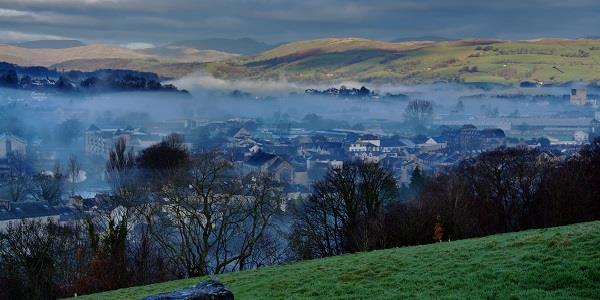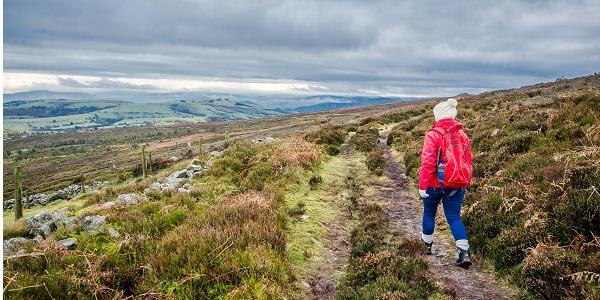
Thirty-three miles due south of Braithwaite Court on the A66 and A591 (and 12 miles north of Merlewood on the B5271, A590, A591 and A6), Kendal is a vibrant market town comprised of attractive limestone buildings. Historically, Kendal was one of Britain’s key textile centres, producing ‘Kendal Green’ and other ‘Kendal cottons’ – its many workyards were once replete with small factories processing cloth, as well as foodstuffs and leather goods. Kendal was also a centre for carpet-weaving, shoe-making, and the manufacture of snuff.
 Kendal on a misty morning
Kendal on a misty morning
Today the place is something of a ‘hub’ for South Lakeland, alive with arts, events, and culture.
And great shopping: Kendal was granted a market charter in 1189 (about 400 years after the area was first settled), and markets still play a vital role in the daily life of the town: there’s an indoor market, open six days a week, and a street market takes place on Wednesdays and Saturdays.
 Market day in the town centre
Market day in the town centre
But the town’s greatest claim to fame was the result of a happy accident.
It’s strange how many of the world’s most common products were created in error, or found to have some unlooked-for side benefit that far outweighed their original purpose. Blotting paper, for example, came about because a paper mill worker omitted to add sizing to a batch of paper during the production process. The microwave oven came into being when a US navy radar specialist, tinkering with radio signals, felt the chocolate bar in his pocket begin to melt. Viagra was originally developed to treat hypertension and angina!
In Kendal’s case, in 1869 one Joseph Wiper, who had married into the Kendal-based Thompson confectionary family, supposedly left the boiled solution for a batch of glacier mints out on a worktop, and overnight it turned cloudy and solidified. The result: the first batch of Kendal mint cake, now as then beloved by explorers, mountaineers, and, indeed, fell walkers.
Though the exact recipe is a closely-guarded secret, in terms of ratios, timings and so on, the constituents of Kendal mint cake are simple enough: sugar, glucose, water and peppermint oil, boiled in a copper pan and continuously stirred. When ready, the gloop is poured into moulds and left to set.
And then broken into bars of pure energy, which have seen many an adventurer safely through. Sir Ernest Shackleton took Kendal mint cake with him on his ultimately unsuccessful, but truly heroic, Imperial Trans Antarctic Expedition of 1914 to 1917. In 2004, Charley Boorman and Ewan McGregor tackled their round-the-world motorcycle journey armed with numerous bars of Kendal’s finest. And most famously, Sir Edmund Hillary and his team were fuelled by Kendal mint cake on their conquest of Mount Everest in 1953. Which is why the packaging, to this day, includes the quote: “We sat on the snow and looked at the country far below us…we nibbled Kendal mint cake.”
Another member of that expedition wrote that Kendal mint cake “was easily the most popular item on our high-altitude ration – our only criticism was that we did not have enough of it.”
Not much he could do about that, really. Couldn’t really just pop to the shops for some more. You, however, will face no such deprivation; Kendal mint cake is widely available everywhere – but especially in Kendal and Cumbria. So next time you’re out walking the lakes and fells, be sure to take a bar or two with you. You’ll get just the lift you need to complete your own adventure. From a sweet slab of history.

